HLTENN007 Diploma of Nursing: Administering and Monitoring Medicines
VerifiedAdded on 2023/06/15
|24
|3597
|225
Homework Assignment
AI Summary
This HLTENN007 assignment solution addresses key aspects of administering and monitoring medicines, including the nurse's role, medication schedules, routes of administration, pharmacodynamics, pharmacokinetics, polypharmacy, and the first-pass effect. It covers drug transportation, bioavailability, receptor types, and essential rights of medication administration. The assignment also provides detailed information on various routes of drug delivery, such as oral, sublingual, buccal, inhaled, and injected, along with specific examples. Furthermore, it includes a scenario-based assessment requiring the selection of appropriate pain medication, considering potential drug interactions. This document offers comprehensive insights into safe and effective medication practices for nursing students; additional resources can be found on Desklib.
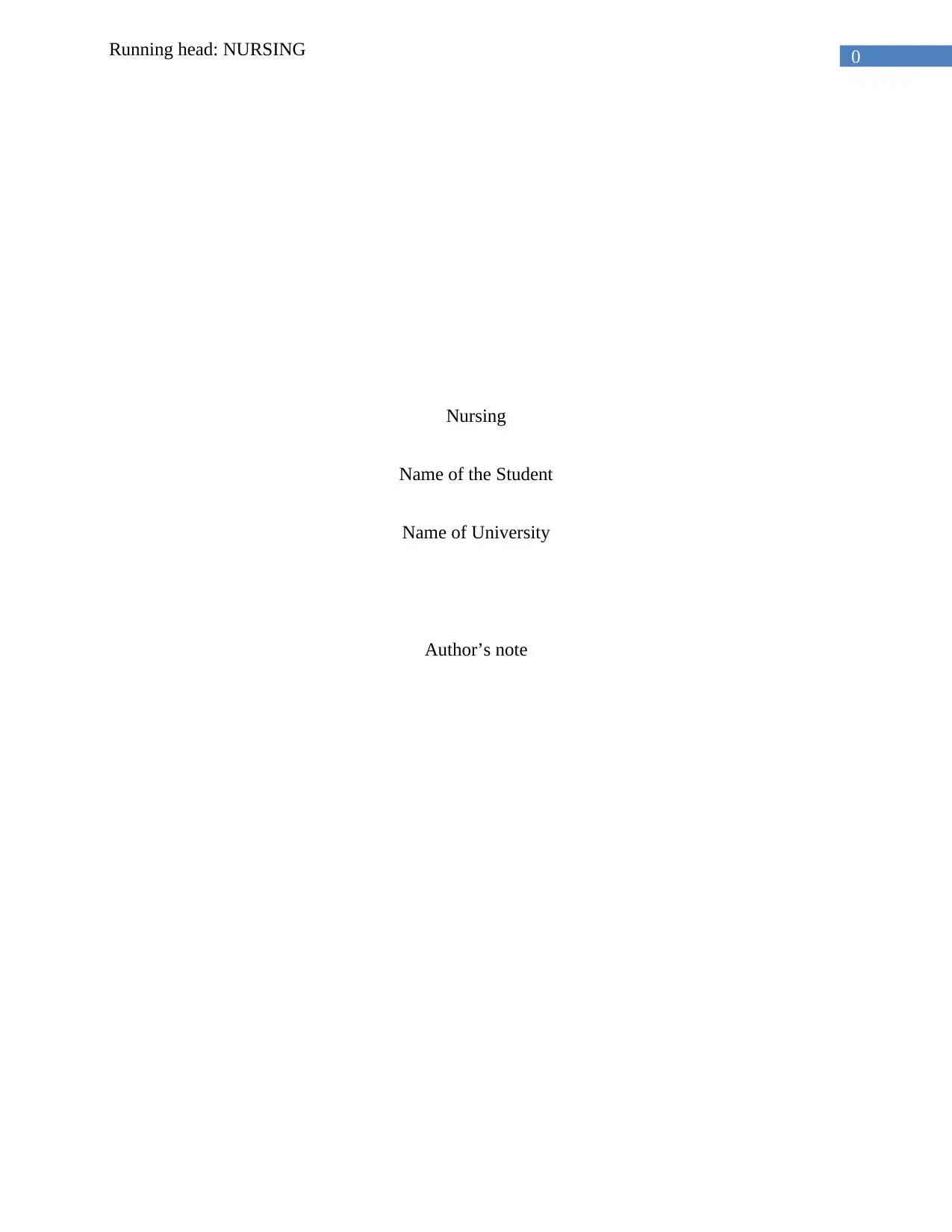
0Running head: NURSING
Nursing
Name of the Student
Name of University
Author’s note
Nursing
Name of the Student
Name of University
Author’s note
Paraphrase This Document
Need a fresh take? Get an instant paraphrase of this document with our AI Paraphraser
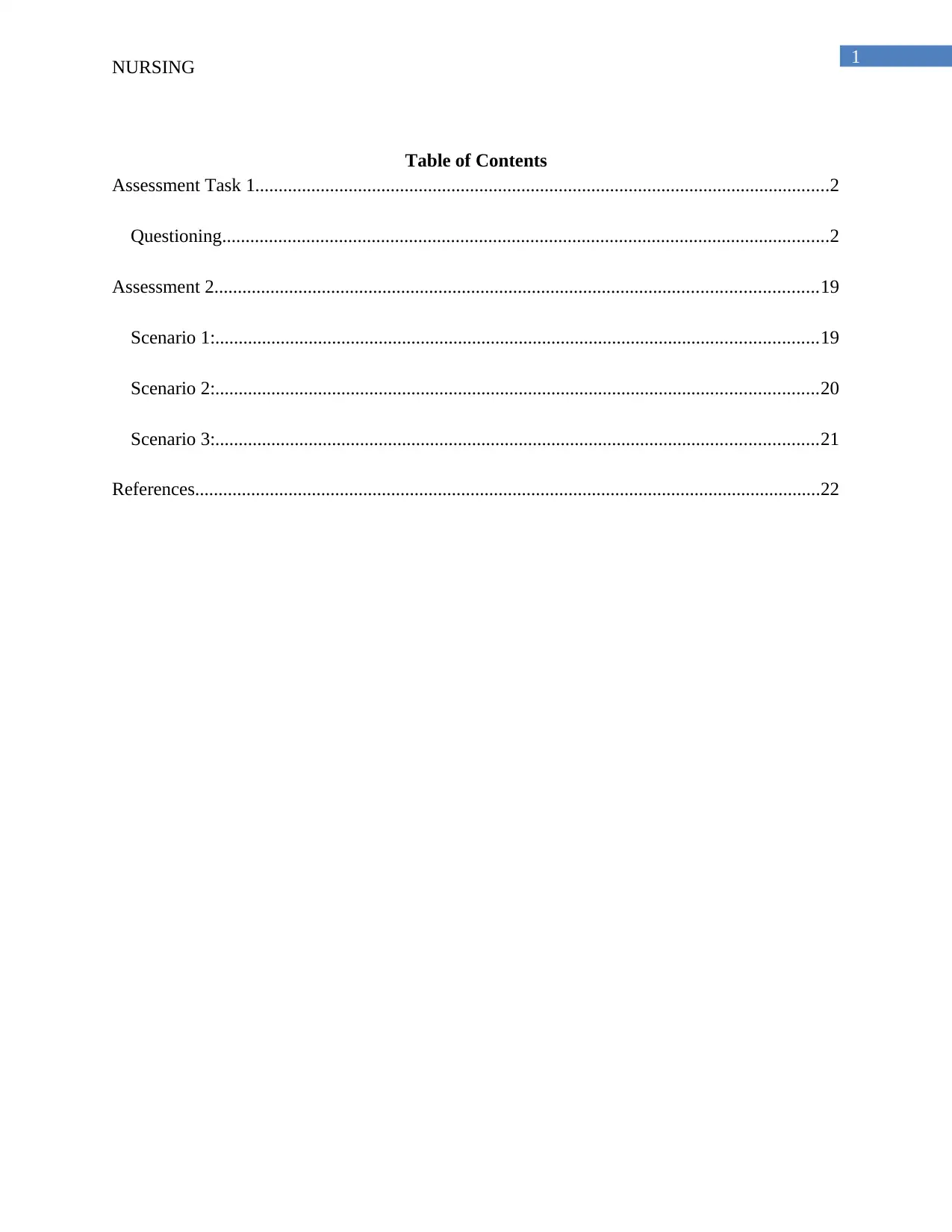
1
NURSING
Table of Contents
Assessment Task 1...........................................................................................................................2
Questioning..................................................................................................................................2
Assessment 2.................................................................................................................................19
Scenario 1:.................................................................................................................................19
Scenario 2:.................................................................................................................................20
Scenario 3:.................................................................................................................................21
References......................................................................................................................................22
NURSING
Table of Contents
Assessment Task 1...........................................................................................................................2
Questioning..................................................................................................................................2
Assessment 2.................................................................................................................................19
Scenario 1:.................................................................................................................................19
Scenario 2:.................................................................................................................................20
Scenario 3:.................................................................................................................................21
References......................................................................................................................................22
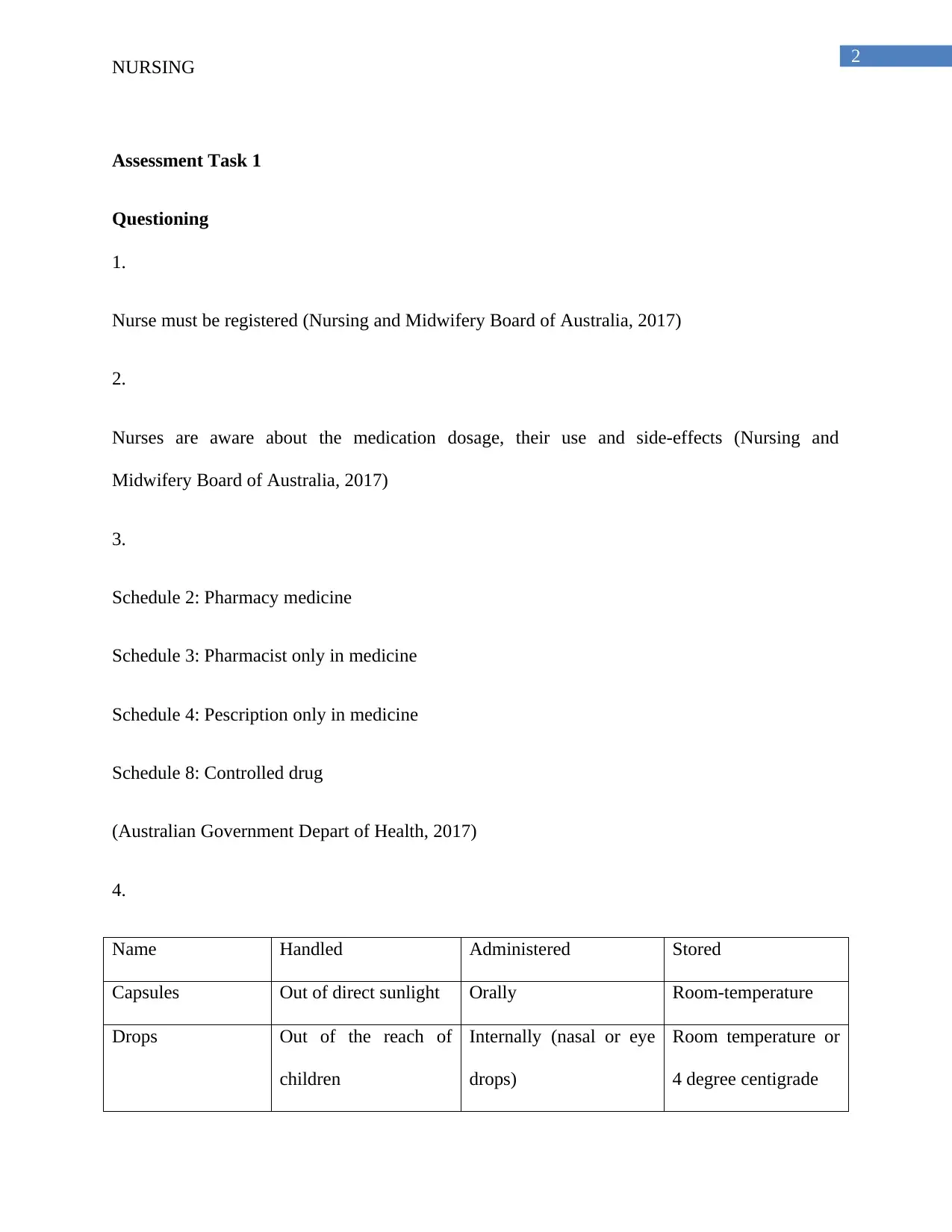
2
NURSING
Assessment Task 1
Questioning
1.
Nurse must be registered (Nursing and Midwifery Board of Australia, 2017)
2.
Nurses are aware about the medication dosage, their use and side-effects (Nursing and
Midwifery Board of Australia, 2017)
3.
Schedule 2: Pharmacy medicine
Schedule 3: Pharmacist only in medicine
Schedule 4: Pescription only in medicine
Schedule 8: Controlled drug
(Australian Government Depart of Health, 2017)
4.
Name Handled Administered Stored
Capsules Out of direct sunlight Orally Room-temperature
Drops Out of the reach of
children
Internally (nasal or eye
drops)
Room temperature or
4 degree centigrade
NURSING
Assessment Task 1
Questioning
1.
Nurse must be registered (Nursing and Midwifery Board of Australia, 2017)
2.
Nurses are aware about the medication dosage, their use and side-effects (Nursing and
Midwifery Board of Australia, 2017)
3.
Schedule 2: Pharmacy medicine
Schedule 3: Pharmacist only in medicine
Schedule 4: Pescription only in medicine
Schedule 8: Controlled drug
(Australian Government Depart of Health, 2017)
4.
Name Handled Administered Stored
Capsules Out of direct sunlight Orally Room-temperature
Drops Out of the reach of
children
Internally (nasal or eye
drops)
Room temperature or
4 degree centigrade
⊘ This is a preview!⊘
Do you want full access?
Subscribe today to unlock all pages.

Trusted by 1+ million students worldwide
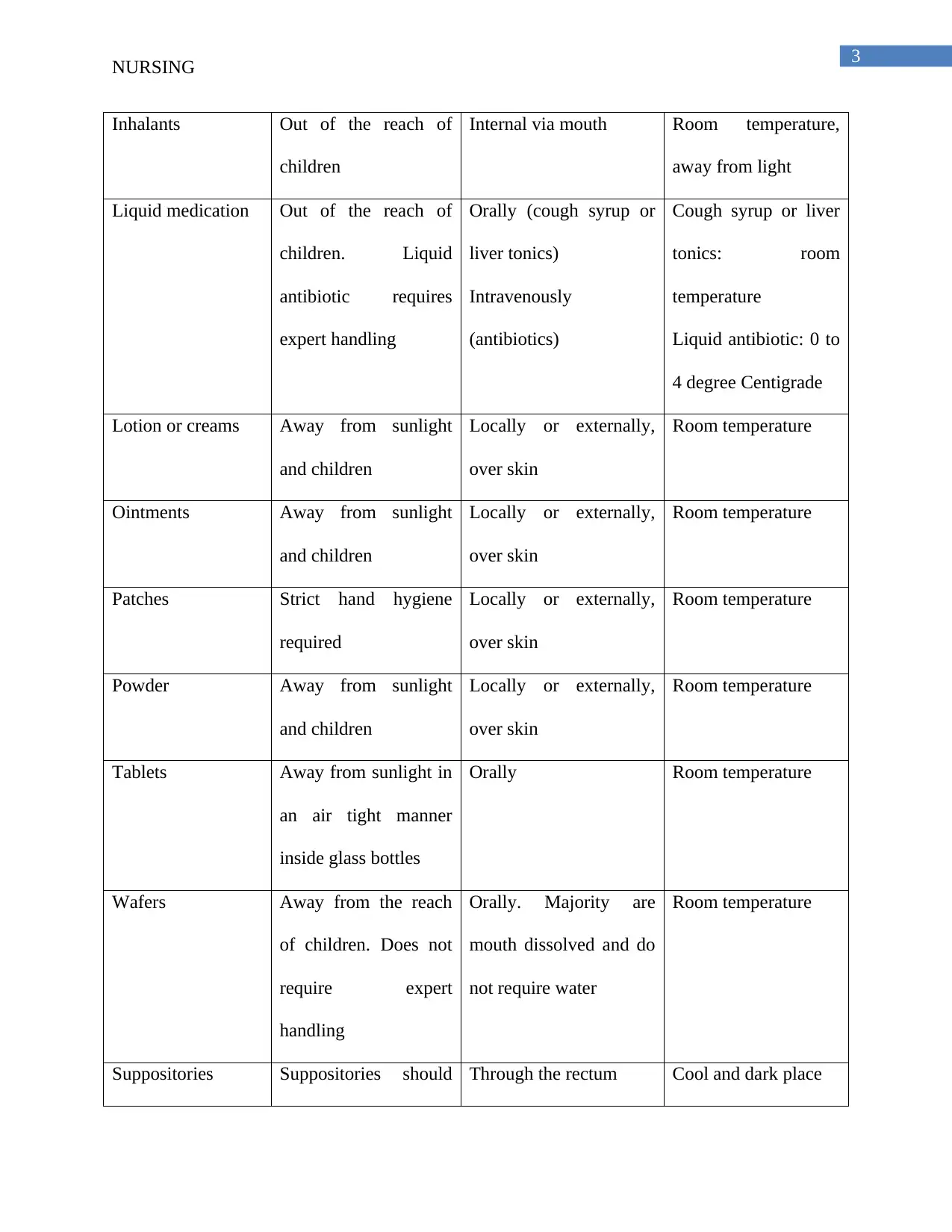
3
NURSING
Inhalants Out of the reach of
children
Internal via mouth Room temperature,
away from light
Liquid medication Out of the reach of
children. Liquid
antibiotic requires
expert handling
Orally (cough syrup or
liver tonics)
Intravenously
(antibiotics)
Cough syrup or liver
tonics: room
temperature
Liquid antibiotic: 0 to
4 degree Centigrade
Lotion or creams Away from sunlight
and children
Locally or externally,
over skin
Room temperature
Ointments Away from sunlight
and children
Locally or externally,
over skin
Room temperature
Patches Strict hand hygiene
required
Locally or externally,
over skin
Room temperature
Powder Away from sunlight
and children
Locally or externally,
over skin
Room temperature
Tablets Away from sunlight in
an air tight manner
inside glass bottles
Orally Room temperature
Wafers Away from the reach
of children. Does not
require expert
handling
Orally. Majority are
mouth dissolved and do
not require water
Room temperature
Suppositories Suppositories should Through the rectum Cool and dark place
NURSING
Inhalants Out of the reach of
children
Internal via mouth Room temperature,
away from light
Liquid medication Out of the reach of
children. Liquid
antibiotic requires
expert handling
Orally (cough syrup or
liver tonics)
Intravenously
(antibiotics)
Cough syrup or liver
tonics: room
temperature
Liquid antibiotic: 0 to
4 degree Centigrade
Lotion or creams Away from sunlight
and children
Locally or externally,
over skin
Room temperature
Ointments Away from sunlight
and children
Locally or externally,
over skin
Room temperature
Patches Strict hand hygiene
required
Locally or externally,
over skin
Room temperature
Powder Away from sunlight
and children
Locally or externally,
over skin
Room temperature
Tablets Away from sunlight in
an air tight manner
inside glass bottles
Orally Room temperature
Wafers Away from the reach
of children. Does not
require expert
handling
Orally. Majority are
mouth dissolved and do
not require water
Room temperature
Suppositories Suppositories should Through the rectum Cool and dark place
Paraphrase This Document
Need a fresh take? Get an instant paraphrase of this document with our AI Paraphraser
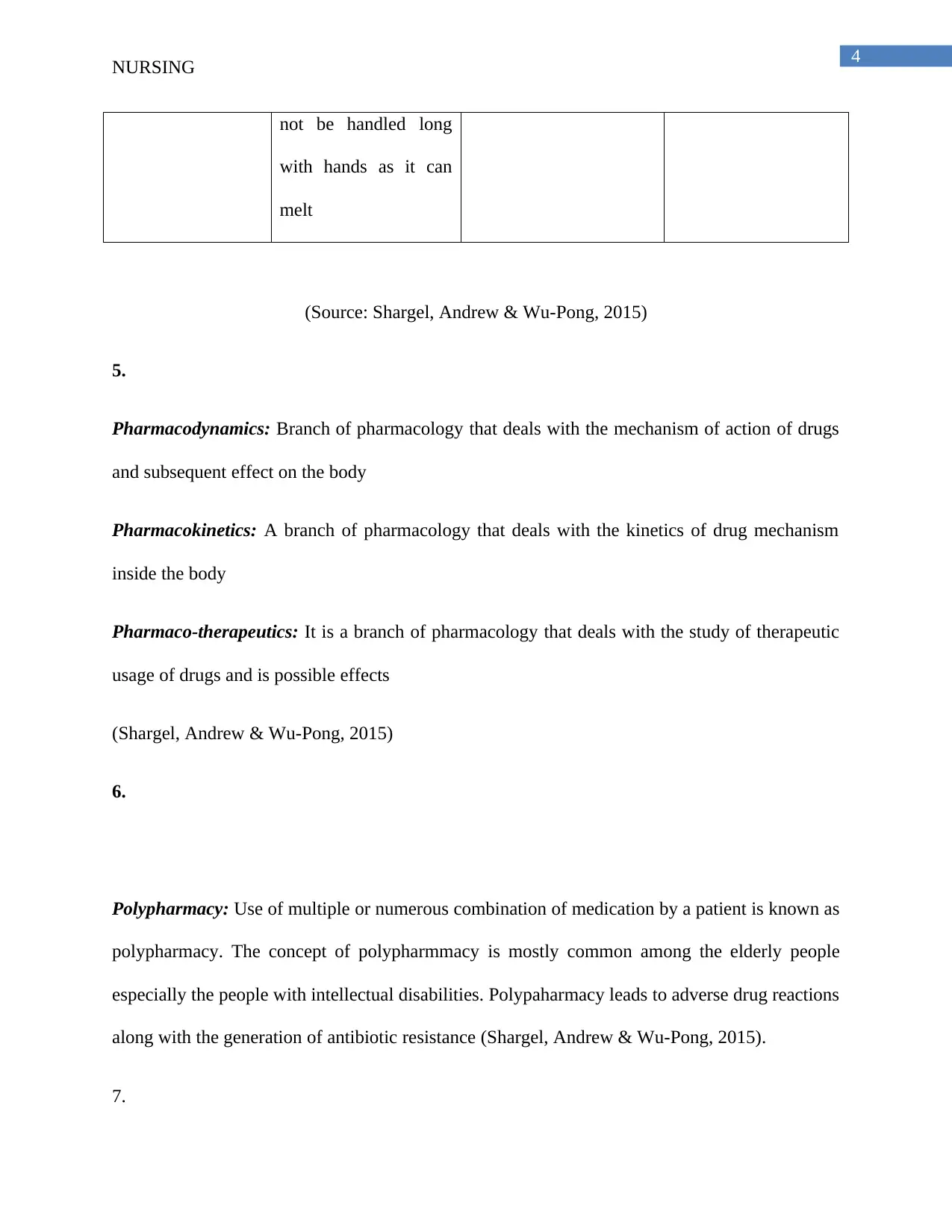
4
NURSING
not be handled long
with hands as it can
melt
(Source: Shargel, Andrew & Wu-Pong, 2015)
5.
Pharmacodynamics: Branch of pharmacology that deals with the mechanism of action of drugs
and subsequent effect on the body
Pharmacokinetics: A branch of pharmacology that deals with the kinetics of drug mechanism
inside the body
Pharmaco-therapeutics: It is a branch of pharmacology that deals with the study of therapeutic
usage of drugs and is possible effects
(Shargel, Andrew & Wu-Pong, 2015)
6.
Polypharmacy: Use of multiple or numerous combination of medication by a patient is known as
polypharmacy. The concept of polypharmmacy is mostly common among the elderly people
especially the people with intellectual disabilities. Polypaharmacy leads to adverse drug reactions
along with the generation of antibiotic resistance (Shargel, Andrew & Wu-Pong, 2015).
7.
NURSING
not be handled long
with hands as it can
melt
(Source: Shargel, Andrew & Wu-Pong, 2015)
5.
Pharmacodynamics: Branch of pharmacology that deals with the mechanism of action of drugs
and subsequent effect on the body
Pharmacokinetics: A branch of pharmacology that deals with the kinetics of drug mechanism
inside the body
Pharmaco-therapeutics: It is a branch of pharmacology that deals with the study of therapeutic
usage of drugs and is possible effects
(Shargel, Andrew & Wu-Pong, 2015)
6.
Polypharmacy: Use of multiple or numerous combination of medication by a patient is known as
polypharmacy. The concept of polypharmmacy is mostly common among the elderly people
especially the people with intellectual disabilities. Polypaharmacy leads to adverse drug reactions
along with the generation of antibiotic resistance (Shargel, Andrew & Wu-Pong, 2015).
7.
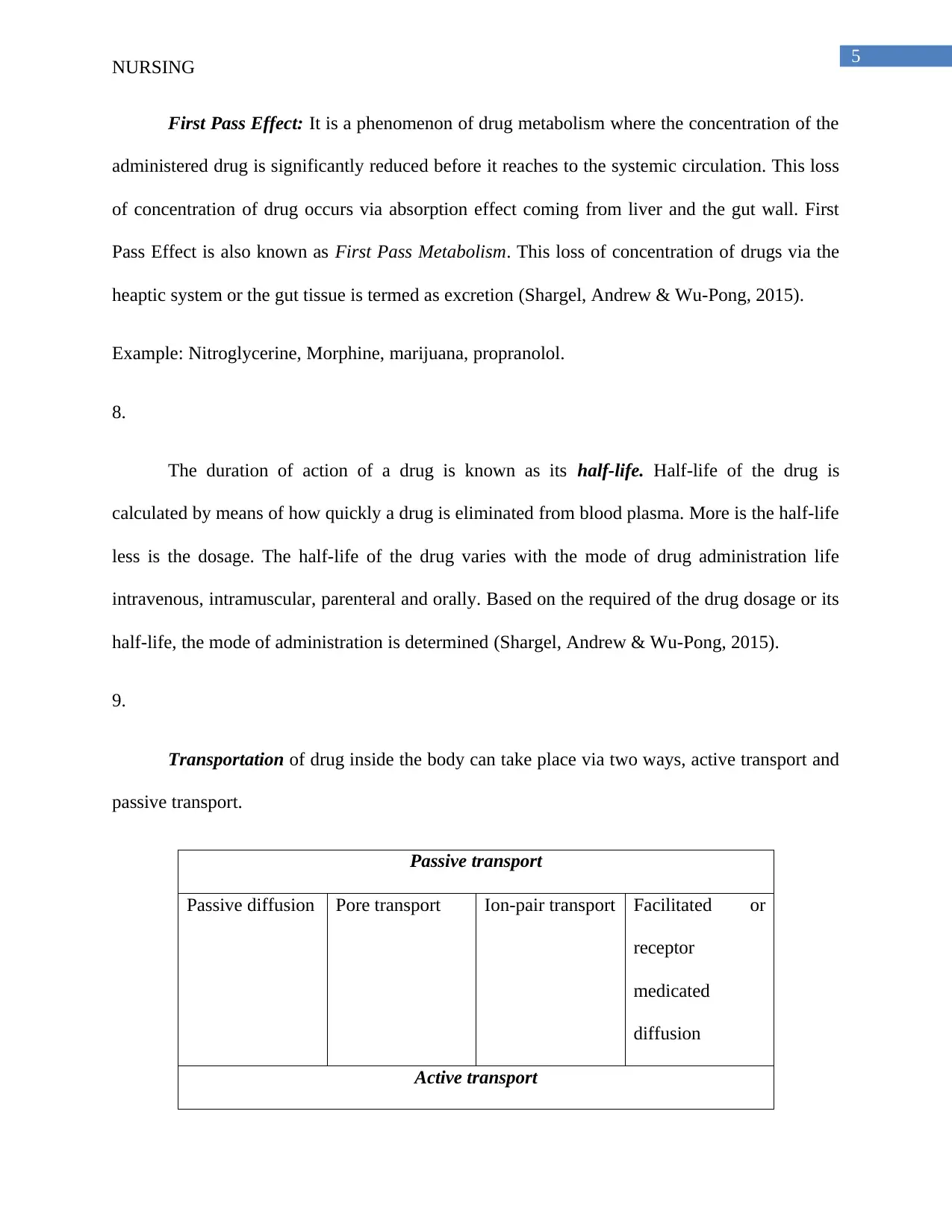
5
NURSING
First Pass Effect: It is a phenomenon of drug metabolism where the concentration of the
administered drug is significantly reduced before it reaches to the systemic circulation. This loss
of concentration of drug occurs via absorption effect coming from liver and the gut wall. First
Pass Effect is also known as First Pass Metabolism. This loss of concentration of drugs via the
heaptic system or the gut tissue is termed as excretion (Shargel, Andrew & Wu-Pong, 2015).
Example: Nitroglycerine, Morphine, marijuana, propranolol.
8.
The duration of action of a drug is known as its half-life. Half-life of the drug is
calculated by means of how quickly a drug is eliminated from blood plasma. More is the half-life
less is the dosage. The half-life of the drug varies with the mode of drug administration life
intravenous, intramuscular, parenteral and orally. Based on the required of the drug dosage or its
half-life, the mode of administration is determined (Shargel, Andrew & Wu-Pong, 2015).
9.
Transportation of drug inside the body can take place via two ways, active transport and
passive transport.
Passive transport
Passive diffusion Pore transport Ion-pair transport Facilitated or
receptor
medicated
diffusion
Active transport
NURSING
First Pass Effect: It is a phenomenon of drug metabolism where the concentration of the
administered drug is significantly reduced before it reaches to the systemic circulation. This loss
of concentration of drug occurs via absorption effect coming from liver and the gut wall. First
Pass Effect is also known as First Pass Metabolism. This loss of concentration of drugs via the
heaptic system or the gut tissue is termed as excretion (Shargel, Andrew & Wu-Pong, 2015).
Example: Nitroglycerine, Morphine, marijuana, propranolol.
8.
The duration of action of a drug is known as its half-life. Half-life of the drug is
calculated by means of how quickly a drug is eliminated from blood plasma. More is the half-life
less is the dosage. The half-life of the drug varies with the mode of drug administration life
intravenous, intramuscular, parenteral and orally. Based on the required of the drug dosage or its
half-life, the mode of administration is determined (Shargel, Andrew & Wu-Pong, 2015).
9.
Transportation of drug inside the body can take place via two ways, active transport and
passive transport.
Passive transport
Passive diffusion Pore transport Ion-pair transport Facilitated or
receptor
medicated
diffusion
Active transport
⊘ This is a preview!⊘
Do you want full access?
Subscribe today to unlock all pages.

Trusted by 1+ million students worldwide
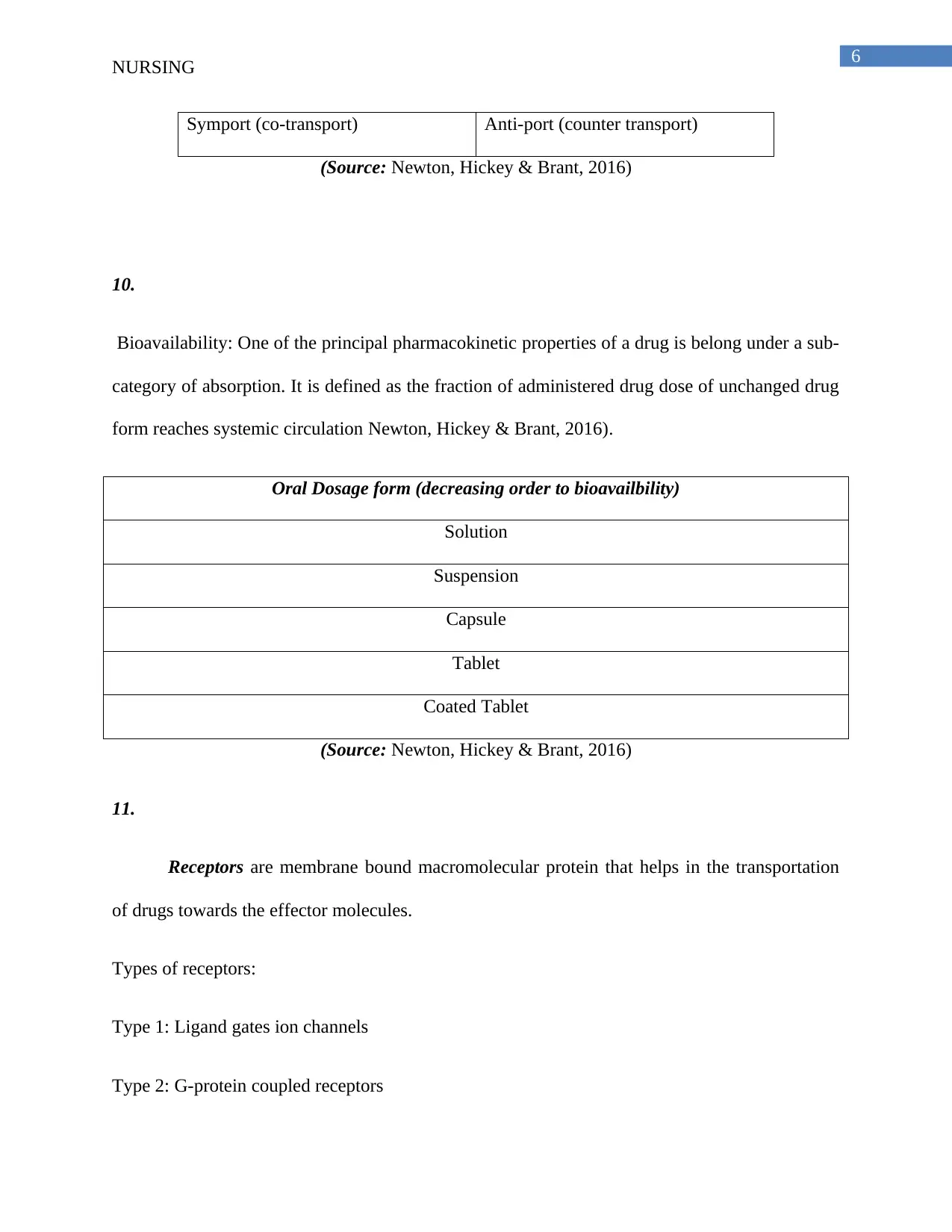
6
NURSING
Symport (co-transport) Anti-port (counter transport)
(Source: Newton, Hickey & Brant, 2016)
10.
Bioavailability: One of the principal pharmacokinetic properties of a drug is belong under a sub-
category of absorption. It is defined as the fraction of administered drug dose of unchanged drug
form reaches systemic circulation Newton, Hickey & Brant, 2016).
Oral Dosage form (decreasing order to bioavailbility)
Solution
Suspension
Capsule
Tablet
Coated Tablet
(Source: Newton, Hickey & Brant, 2016)
11.
Receptors are membrane bound macromolecular protein that helps in the transportation
of drugs towards the effector molecules.
Types of receptors:
Type 1: Ligand gates ion channels
Type 2: G-protein coupled receptors
NURSING
Symport (co-transport) Anti-port (counter transport)
(Source: Newton, Hickey & Brant, 2016)
10.
Bioavailability: One of the principal pharmacokinetic properties of a drug is belong under a sub-
category of absorption. It is defined as the fraction of administered drug dose of unchanged drug
form reaches systemic circulation Newton, Hickey & Brant, 2016).
Oral Dosage form (decreasing order to bioavailbility)
Solution
Suspension
Capsule
Tablet
Coated Tablet
(Source: Newton, Hickey & Brant, 2016)
11.
Receptors are membrane bound macromolecular protein that helps in the transportation
of drugs towards the effector molecules.
Types of receptors:
Type 1: Ligand gates ion channels
Type 2: G-protein coupled receptors
Paraphrase This Document
Need a fresh take? Get an instant paraphrase of this document with our AI Paraphraser
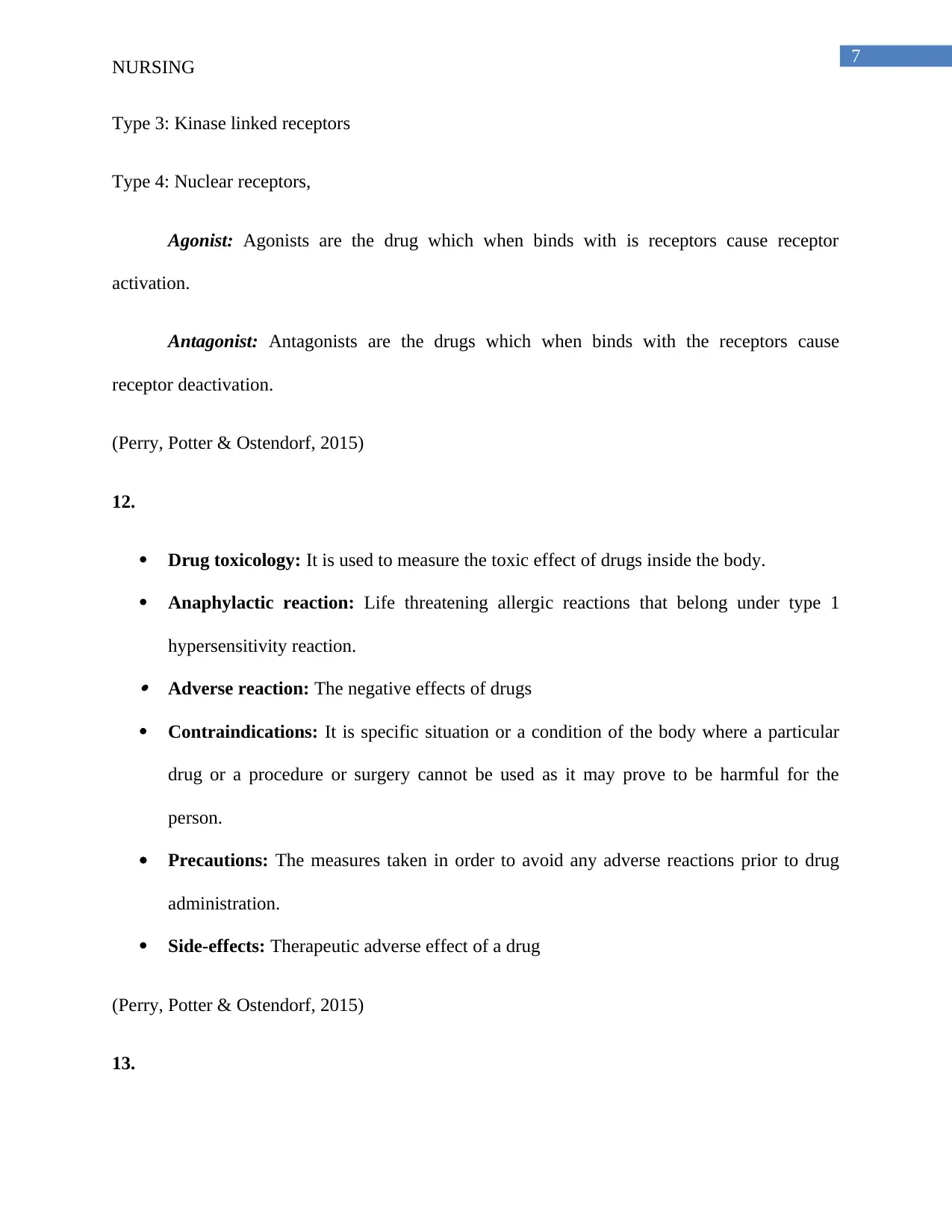
7
NURSING
Type 3: Kinase linked receptors
Type 4: Nuclear receptors,
Agonist: Agonists are the drug which when binds with is receptors cause receptor
activation.
Antagonist: Antagonists are the drugs which when binds with the receptors cause
receptor deactivation.
(Perry, Potter & Ostendorf, 2015)
12.
Drug toxicology: It is used to measure the toxic effect of drugs inside the body.
Anaphylactic reaction: Life threatening allergic reactions that belong under type 1
hypersensitivity reaction. Adverse reaction: The negative effects of drugs
Contraindications: It is specific situation or a condition of the body where a particular
drug or a procedure or surgery cannot be used as it may prove to be harmful for the
person.
Precautions: The measures taken in order to avoid any adverse reactions prior to drug
administration.
Side-effects: Therapeutic adverse effect of a drug
(Perry, Potter & Ostendorf, 2015)
13.
NURSING
Type 3: Kinase linked receptors
Type 4: Nuclear receptors,
Agonist: Agonists are the drug which when binds with is receptors cause receptor
activation.
Antagonist: Antagonists are the drugs which when binds with the receptors cause
receptor deactivation.
(Perry, Potter & Ostendorf, 2015)
12.
Drug toxicology: It is used to measure the toxic effect of drugs inside the body.
Anaphylactic reaction: Life threatening allergic reactions that belong under type 1
hypersensitivity reaction. Adverse reaction: The negative effects of drugs
Contraindications: It is specific situation or a condition of the body where a particular
drug or a procedure or surgery cannot be used as it may prove to be harmful for the
person.
Precautions: The measures taken in order to avoid any adverse reactions prior to drug
administration.
Side-effects: Therapeutic adverse effect of a drug
(Perry, Potter & Ostendorf, 2015)
13.
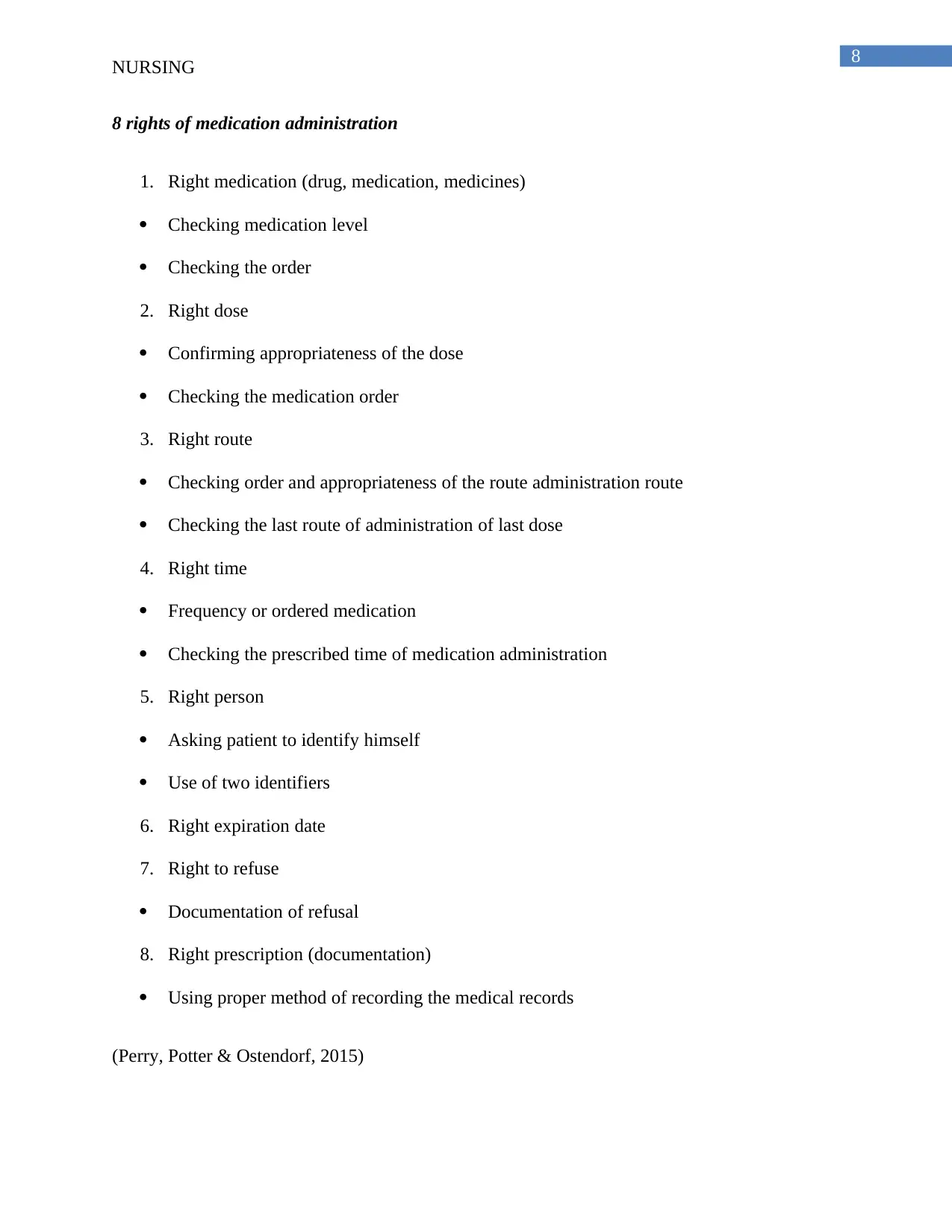
8
NURSING
8 rights of medication administration
1. Right medication (drug, medication, medicines)
Checking medication level
Checking the order
2. Right dose
Confirming appropriateness of the dose
Checking the medication order
3. Right route
Checking order and appropriateness of the route administration route
Checking the last route of administration of last dose
4. Right time
Frequency or ordered medication
Checking the prescribed time of medication administration
5. Right person
Asking patient to identify himself
Use of two identifiers
6. Right expiration date
7. Right to refuse
Documentation of refusal
8. Right prescription (documentation)
Using proper method of recording the medical records
(Perry, Potter & Ostendorf, 2015)
NURSING
8 rights of medication administration
1. Right medication (drug, medication, medicines)
Checking medication level
Checking the order
2. Right dose
Confirming appropriateness of the dose
Checking the medication order
3. Right route
Checking order and appropriateness of the route administration route
Checking the last route of administration of last dose
4. Right time
Frequency or ordered medication
Checking the prescribed time of medication administration
5. Right person
Asking patient to identify himself
Use of two identifiers
6. Right expiration date
7. Right to refuse
Documentation of refusal
8. Right prescription (documentation)
Using proper method of recording the medical records
(Perry, Potter & Ostendorf, 2015)
⊘ This is a preview!⊘
Do you want full access?
Subscribe today to unlock all pages.

Trusted by 1+ million students worldwide
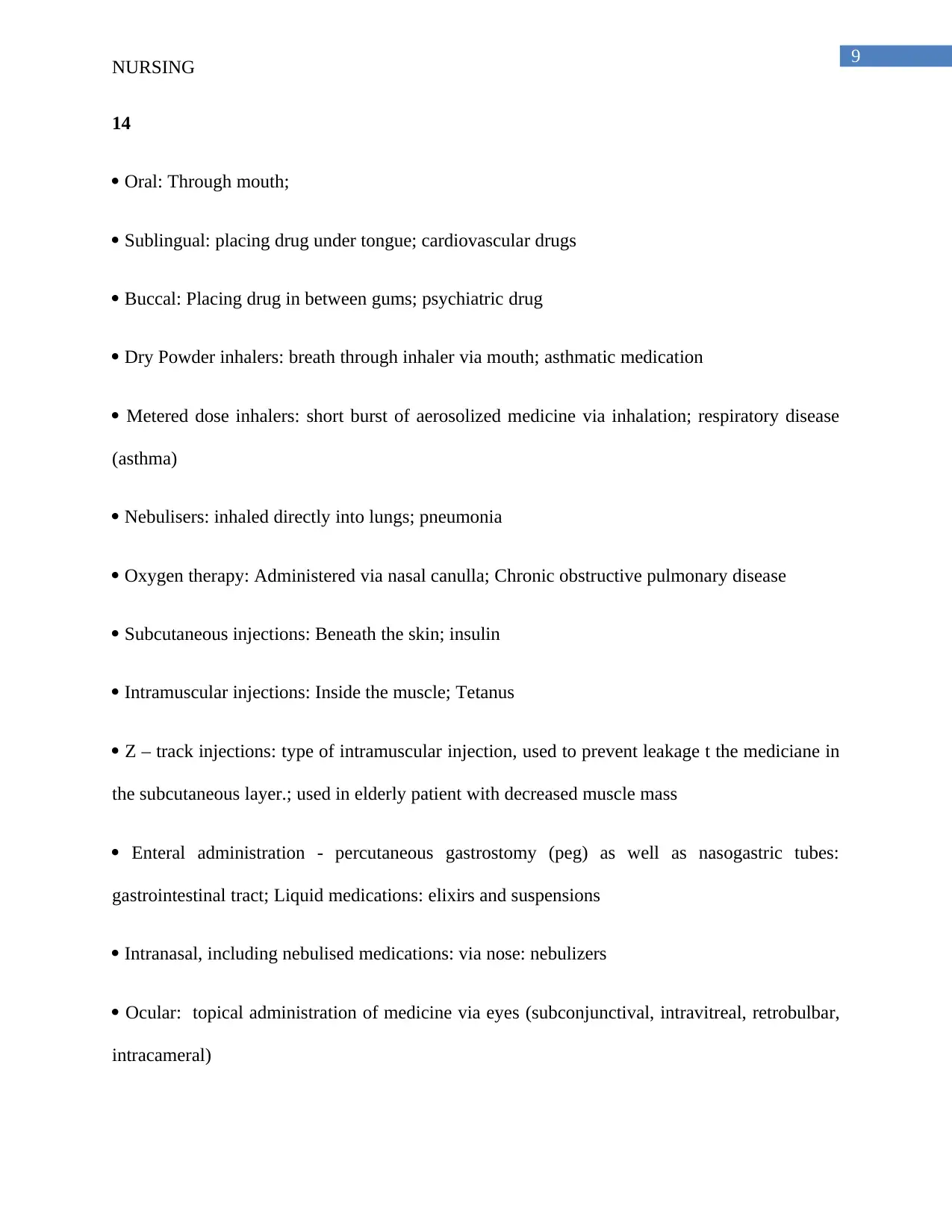
9
NURSING
14
Oral: Through mouth;
Sublingual: placing drug under tongue; cardiovascular drugs
Buccal: Placing drug in between gums; psychiatric drug
Dry Powder inhalers: breath through inhaler via mouth; asthmatic medication
Metered dose inhalers: short burst of aerosolized medicine via inhalation; respiratory disease
(asthma)
Nebulisers: inhaled directly into lungs; pneumonia
Oxygen therapy: Administered via nasal canulla; Chronic obstructive pulmonary disease
Subcutaneous injections: Beneath the skin; insulin
Intramuscular injections: Inside the muscle; Tetanus
Z – track injections: type of intramuscular injection, used to prevent leakage t the mediciane in
the subcutaneous layer.; used in elderly patient with decreased muscle mass
Enteral administration - percutaneous gastrostomy (peg) as well as nasogastric tubes:
gastrointestinal tract; Liquid medications: elixirs and suspensions
Intranasal, including nebulised medications: via nose: nebulizers
Ocular: topical administration of medicine via eyes (subconjunctival, intravitreal, retrobulbar,
intracameral)
NURSING
14
Oral: Through mouth;
Sublingual: placing drug under tongue; cardiovascular drugs
Buccal: Placing drug in between gums; psychiatric drug
Dry Powder inhalers: breath through inhaler via mouth; asthmatic medication
Metered dose inhalers: short burst of aerosolized medicine via inhalation; respiratory disease
(asthma)
Nebulisers: inhaled directly into lungs; pneumonia
Oxygen therapy: Administered via nasal canulla; Chronic obstructive pulmonary disease
Subcutaneous injections: Beneath the skin; insulin
Intramuscular injections: Inside the muscle; Tetanus
Z – track injections: type of intramuscular injection, used to prevent leakage t the mediciane in
the subcutaneous layer.; used in elderly patient with decreased muscle mass
Enteral administration - percutaneous gastrostomy (peg) as well as nasogastric tubes:
gastrointestinal tract; Liquid medications: elixirs and suspensions
Intranasal, including nebulised medications: via nose: nebulizers
Ocular: topical administration of medicine via eyes (subconjunctival, intravitreal, retrobulbar,
intracameral)
Paraphrase This Document
Need a fresh take? Get an instant paraphrase of this document with our AI Paraphraser
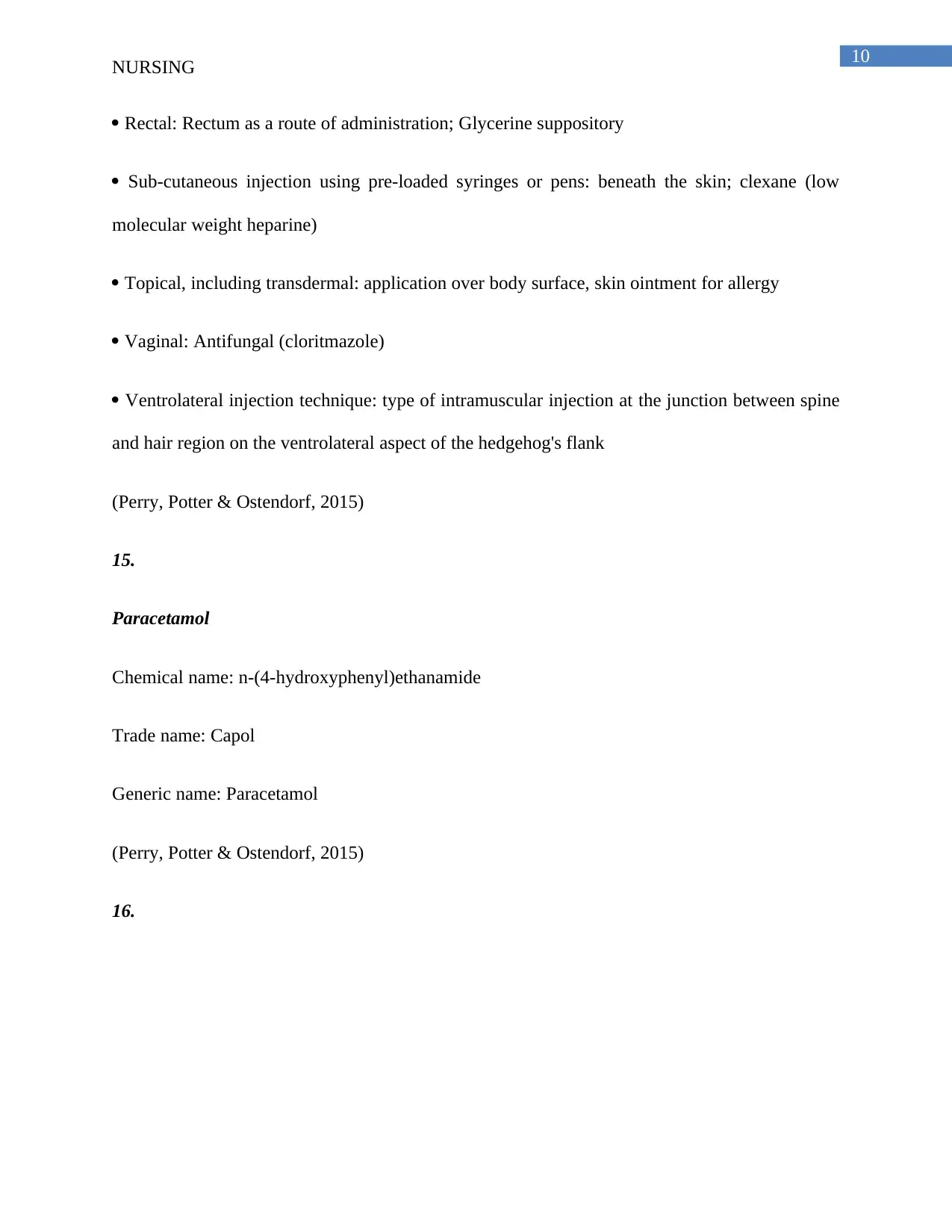
10
NURSING
Rectal: Rectum as a route of administration; Glycerine suppository
Sub-cutaneous injection using pre-loaded syringes or pens: beneath the skin; clexane (low
molecular weight heparine)
Topical, including transdermal: application over body surface, skin ointment for allergy
Vaginal: Antifungal (cloritmazole)
Ventrolateral injection technique: type of intramuscular injection at the junction between spine
and hair region on the ventrolateral aspect of the hedgehog's flank
(Perry, Potter & Ostendorf, 2015)
15.
Paracetamol
Chemical name: n-(4-hydroxyphenyl)ethanamide
Trade name: Capol
Generic name: Paracetamol
(Perry, Potter & Ostendorf, 2015)
16.
NURSING
Rectal: Rectum as a route of administration; Glycerine suppository
Sub-cutaneous injection using pre-loaded syringes or pens: beneath the skin; clexane (low
molecular weight heparine)
Topical, including transdermal: application over body surface, skin ointment for allergy
Vaginal: Antifungal (cloritmazole)
Ventrolateral injection technique: type of intramuscular injection at the junction between spine
and hair region on the ventrolateral aspect of the hedgehog's flank
(Perry, Potter & Ostendorf, 2015)
15.
Paracetamol
Chemical name: n-(4-hydroxyphenyl)ethanamide
Trade name: Capol
Generic name: Paracetamol
(Perry, Potter & Ostendorf, 2015)
16.
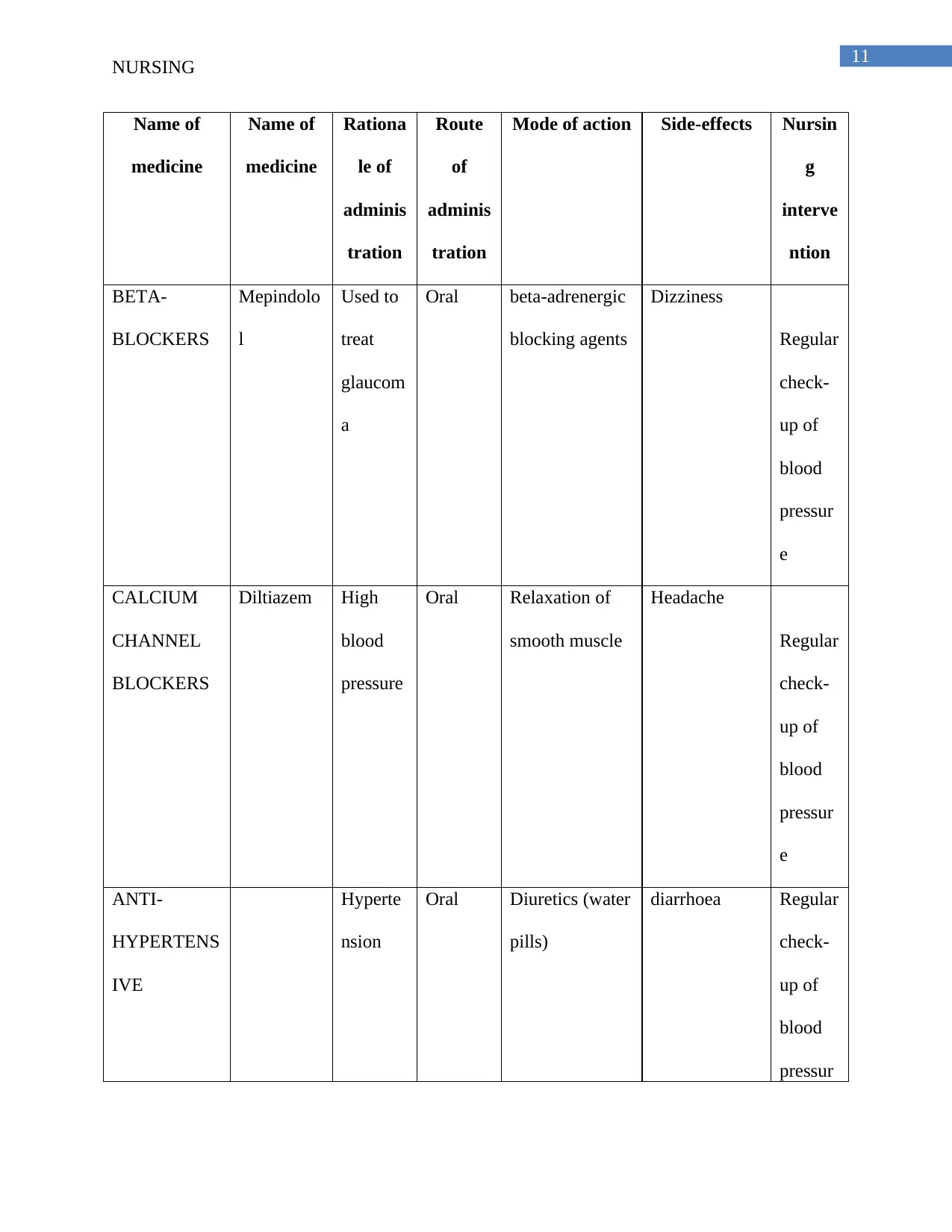
11
NURSING
Name of
medicine
Name of
medicine
Rationa
le of
adminis
tration
Route
of
adminis
tration
Mode of action Side-effects Nursin
g
interve
ntion
BETA-
BLOCKERS
Mepindolo
l
Used to
treat
glaucom
a
Oral beta-adrenergic
blocking agents
Dizziness
Regular
check-
up of
blood
pressur
e
CALCIUM
CHANNEL
BLOCKERS
Diltiazem High
blood
pressure
Oral Relaxation of
smooth muscle
Headache
Regular
check-
up of
blood
pressur
e
ANTI-
HYPERTENS
IVE
Hyperte
nsion
Oral Diuretics (water
pills)
diarrhoea Regular
check-
up of
blood
pressur
NURSING
Name of
medicine
Name of
medicine
Rationa
le of
adminis
tration
Route
of
adminis
tration
Mode of action Side-effects Nursin
g
interve
ntion
BETA-
BLOCKERS
Mepindolo
l
Used to
treat
glaucom
a
Oral beta-adrenergic
blocking agents
Dizziness
Regular
check-
up of
blood
pressur
e
CALCIUM
CHANNEL
BLOCKERS
Diltiazem High
blood
pressure
Oral Relaxation of
smooth muscle
Headache
Regular
check-
up of
blood
pressur
e
ANTI-
HYPERTENS
IVE
Hyperte
nsion
Oral Diuretics (water
pills)
diarrhoea Regular
check-
up of
blood
pressur
⊘ This is a preview!⊘
Do you want full access?
Subscribe today to unlock all pages.

Trusted by 1+ million students worldwide
1 out of 24
Your All-in-One AI-Powered Toolkit for Academic Success.
+13062052269
info@desklib.com
Available 24*7 on WhatsApp / Email
![[object Object]](/_next/static/media/star-bottom.7253800d.svg)
Unlock your academic potential
Copyright © 2020–2025 A2Z Services. All Rights Reserved. Developed and managed by ZUCOL.
